Understanding Multiple Sclerosis (MS) in Elementary Children: Causes, Diagnosis, and Treatment
VerifiedAdded on 2023/04/25
|9
|2041
|465
Assignment
AI Summary
In this assignment we will discuss about multiple sclerosis (MS) & elementary children and below are the summaries point:-
Multiple Sclerosis (MS) is an autoimmune disease affecting the central nervous system.
MS can also affect elementary children, with equal prevalence among boys and girls.
Diagnosis of childhood MS involves examining medical history and evidence of neurologic attacks.
Contribute Materials
Your contribution can guide someone’s learning journey. Share your
documents today.
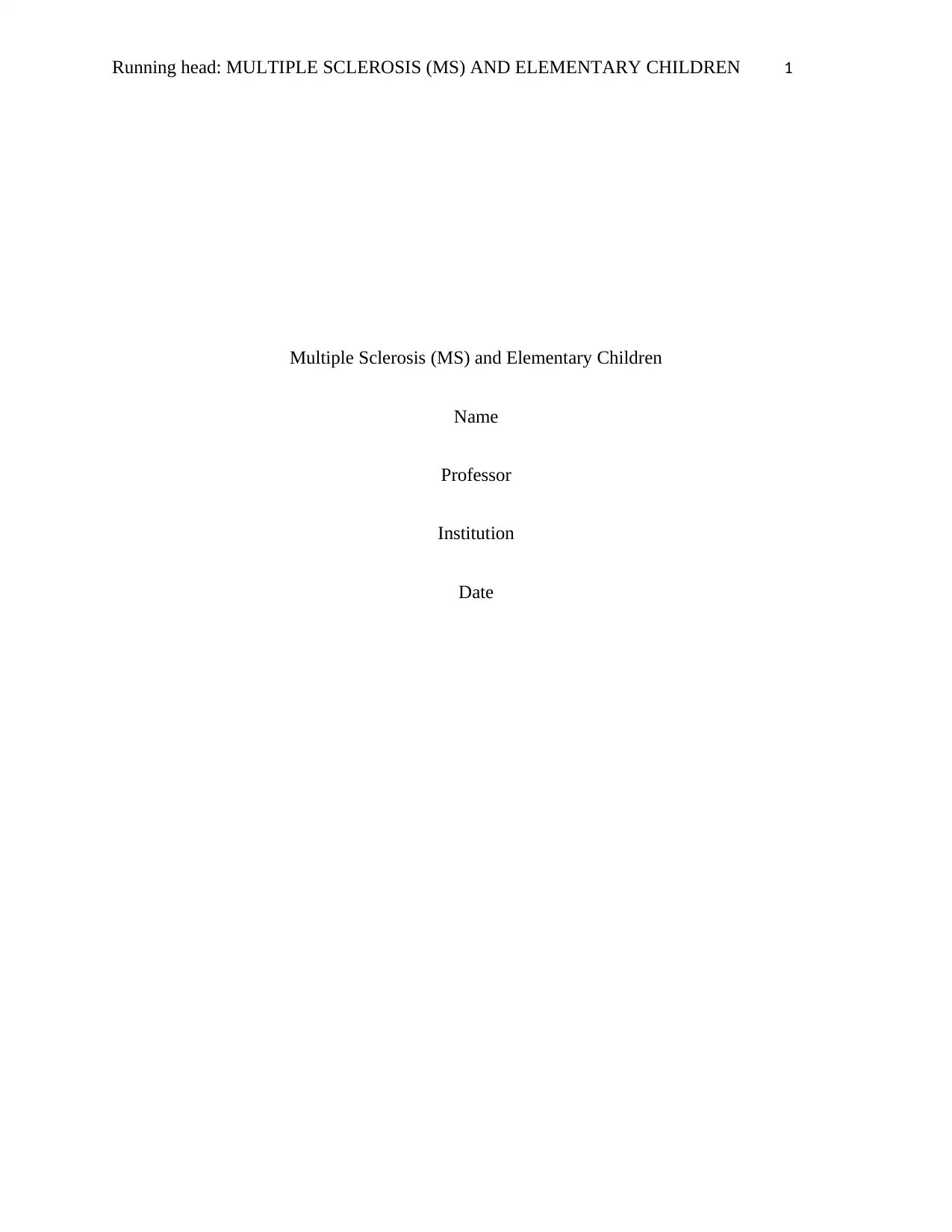
Running head: MULTIPLE SCLEROSIS (MS) AND ELEMENTARY CHILDREN 1
Multiple Sclerosis (MS) and Elementary Children
Name
Professor
Institution
Date
Multiple Sclerosis (MS) and Elementary Children
Name
Professor
Institution
Date
Secure Best Marks with AI Grader
Need help grading? Try our AI Grader for instant feedback on your assignments.
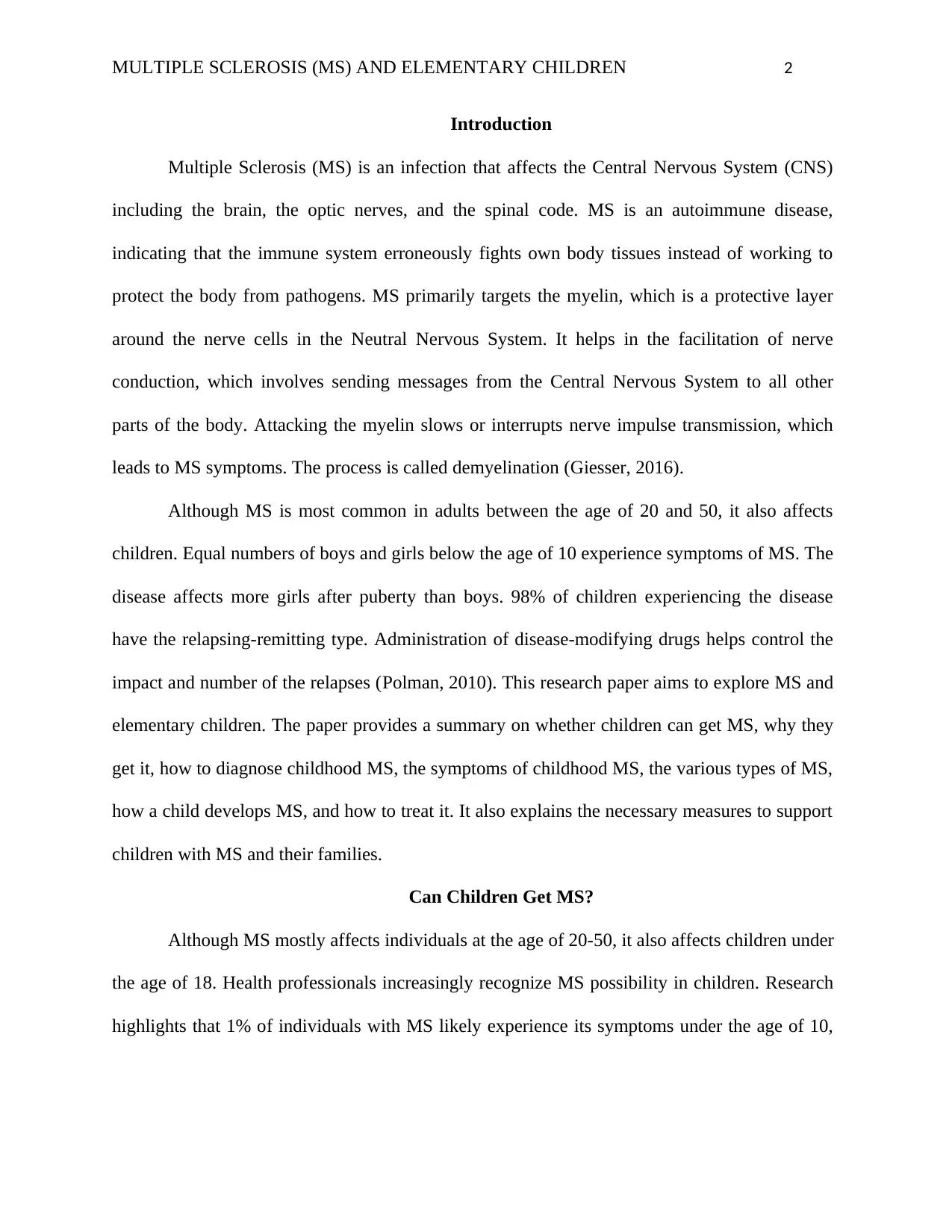
MULTIPLE SCLEROSIS (MS) AND ELEMENTARY CHILDREN 2
Introduction
Multiple Sclerosis (MS) is an infection that affects the Central Nervous System (CNS)
including the brain, the optic nerves, and the spinal code. MS is an autoimmune disease,
indicating that the immune system erroneously fights own body tissues instead of working to
protect the body from pathogens. MS primarily targets the myelin, which is a protective layer
around the nerve cells in the Neutral Nervous System. It helps in the facilitation of nerve
conduction, which involves sending messages from the Central Nervous System to all other
parts of the body. Attacking the myelin slows or interrupts nerve impulse transmission, which
leads to MS symptoms. The process is called demyelination (Giesser, 2016).
Although MS is most common in adults between the age of 20 and 50, it also affects
children. Equal numbers of boys and girls below the age of 10 experience symptoms of MS. The
disease affects more girls after puberty than boys. 98% of children experiencing the disease
have the relapsing-remitting type. Administration of disease-modifying drugs helps control the
impact and number of the relapses (Polman, 2010). This research paper aims to explore MS and
elementary children. The paper provides a summary on whether children can get MS, why they
get it, how to diagnose childhood MS, the symptoms of childhood MS, the various types of MS,
how a child develops MS, and how to treat it. It also explains the necessary measures to support
children with MS and their families.
Can Children Get MS?
Although MS mostly affects individuals at the age of 20-50, it also affects children under
the age of 18. Health professionals increasingly recognize MS possibility in children. Research
highlights that 1% of individuals with MS likely experience its symptoms under the age of 10,
Introduction
Multiple Sclerosis (MS) is an infection that affects the Central Nervous System (CNS)
including the brain, the optic nerves, and the spinal code. MS is an autoimmune disease,
indicating that the immune system erroneously fights own body tissues instead of working to
protect the body from pathogens. MS primarily targets the myelin, which is a protective layer
around the nerve cells in the Neutral Nervous System. It helps in the facilitation of nerve
conduction, which involves sending messages from the Central Nervous System to all other
parts of the body. Attacking the myelin slows or interrupts nerve impulse transmission, which
leads to MS symptoms. The process is called demyelination (Giesser, 2016).
Although MS is most common in adults between the age of 20 and 50, it also affects
children. Equal numbers of boys and girls below the age of 10 experience symptoms of MS. The
disease affects more girls after puberty than boys. 98% of children experiencing the disease
have the relapsing-remitting type. Administration of disease-modifying drugs helps control the
impact and number of the relapses (Polman, 2010). This research paper aims to explore MS and
elementary children. The paper provides a summary on whether children can get MS, why they
get it, how to diagnose childhood MS, the symptoms of childhood MS, the various types of MS,
how a child develops MS, and how to treat it. It also explains the necessary measures to support
children with MS and their families.
Can Children Get MS?
Although MS mostly affects individuals at the age of 20-50, it also affects children under
the age of 18. Health professionals increasingly recognize MS possibility in children. Research
highlights that 1% of individuals with MS likely experience its symptoms under the age of 10,
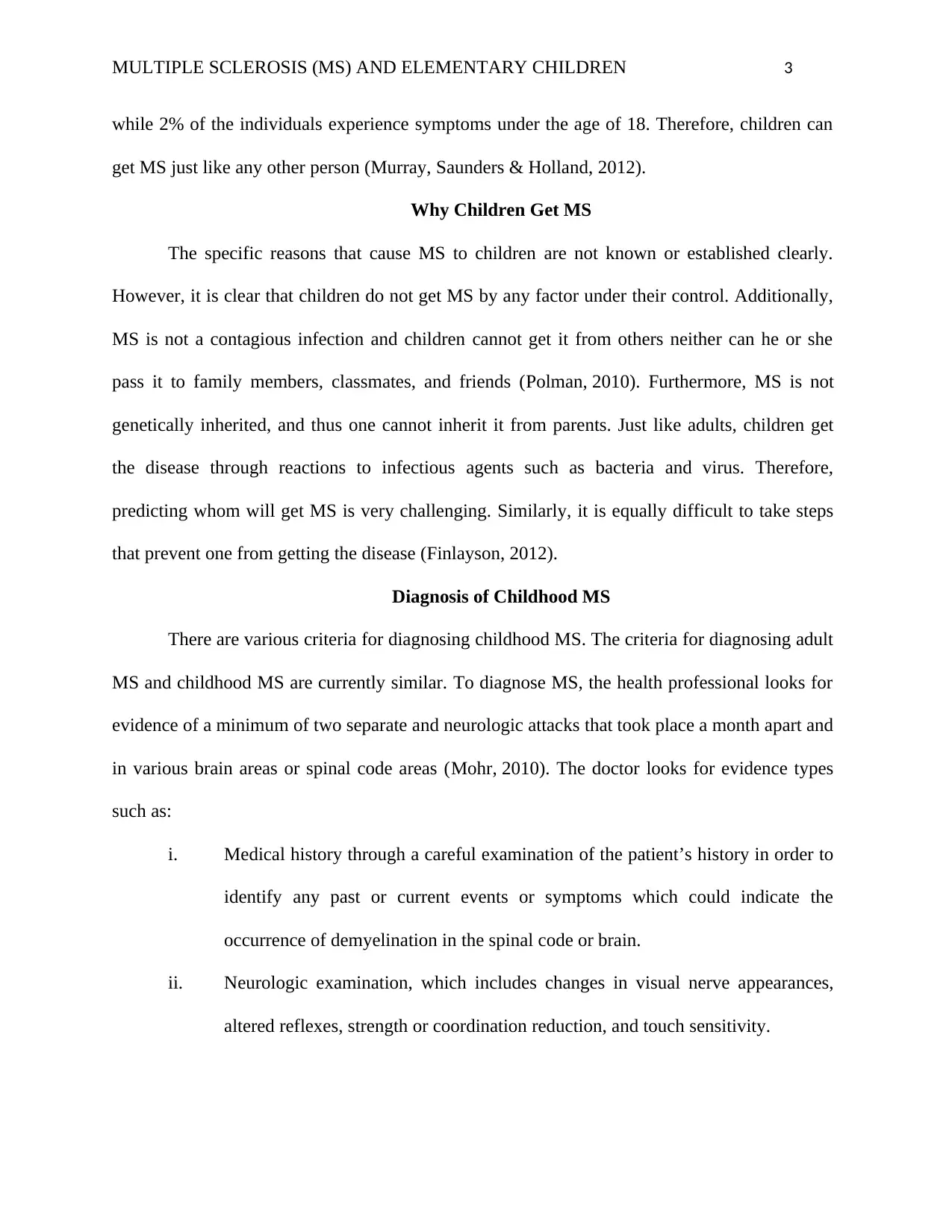
MULTIPLE SCLEROSIS (MS) AND ELEMENTARY CHILDREN 3
while 2% of the individuals experience symptoms under the age of 18. Therefore, children can
get MS just like any other person (Murray, Saunders & Holland, 2012).
Why Children Get MS
The specific reasons that cause MS to children are not known or established clearly.
However, it is clear that children do not get MS by any factor under their control. Additionally,
MS is not a contagious infection and children cannot get it from others neither can he or she
pass it to family members, classmates, and friends (Polman, 2010). Furthermore, MS is not
genetically inherited, and thus one cannot inherit it from parents. Just like adults, children get
the disease through reactions to infectious agents such as bacteria and virus. Therefore,
predicting whom will get MS is very challenging. Similarly, it is equally difficult to take steps
that prevent one from getting the disease (Finlayson, 2012).
Diagnosis of Childhood MS
There are various criteria for diagnosing childhood MS. The criteria for diagnosing adult
MS and childhood MS are currently similar. To diagnose MS, the health professional looks for
evidence of a minimum of two separate and neurologic attacks that took place a month apart and
in various brain areas or spinal code areas (Mohr, 2010). The doctor looks for evidence types
such as:
i. Medical history through a careful examination of the patient’s history in order to
identify any past or current events or symptoms which could indicate the
occurrence of demyelination in the spinal code or brain.
ii. Neurologic examination, which includes changes in visual nerve appearances,
altered reflexes, strength or coordination reduction, and touch sensitivity.
while 2% of the individuals experience symptoms under the age of 18. Therefore, children can
get MS just like any other person (Murray, Saunders & Holland, 2012).
Why Children Get MS
The specific reasons that cause MS to children are not known or established clearly.
However, it is clear that children do not get MS by any factor under their control. Additionally,
MS is not a contagious infection and children cannot get it from others neither can he or she
pass it to family members, classmates, and friends (Polman, 2010). Furthermore, MS is not
genetically inherited, and thus one cannot inherit it from parents. Just like adults, children get
the disease through reactions to infectious agents such as bacteria and virus. Therefore,
predicting whom will get MS is very challenging. Similarly, it is equally difficult to take steps
that prevent one from getting the disease (Finlayson, 2012).
Diagnosis of Childhood MS
There are various criteria for diagnosing childhood MS. The criteria for diagnosing adult
MS and childhood MS are currently similar. To diagnose MS, the health professional looks for
evidence of a minimum of two separate and neurologic attacks that took place a month apart and
in various brain areas or spinal code areas (Mohr, 2010). The doctor looks for evidence types
such as:
i. Medical history through a careful examination of the patient’s history in order to
identify any past or current events or symptoms which could indicate the
occurrence of demyelination in the spinal code or brain.
ii. Neurologic examination, which includes changes in visual nerve appearances,
altered reflexes, strength or coordination reduction, and touch sensitivity.
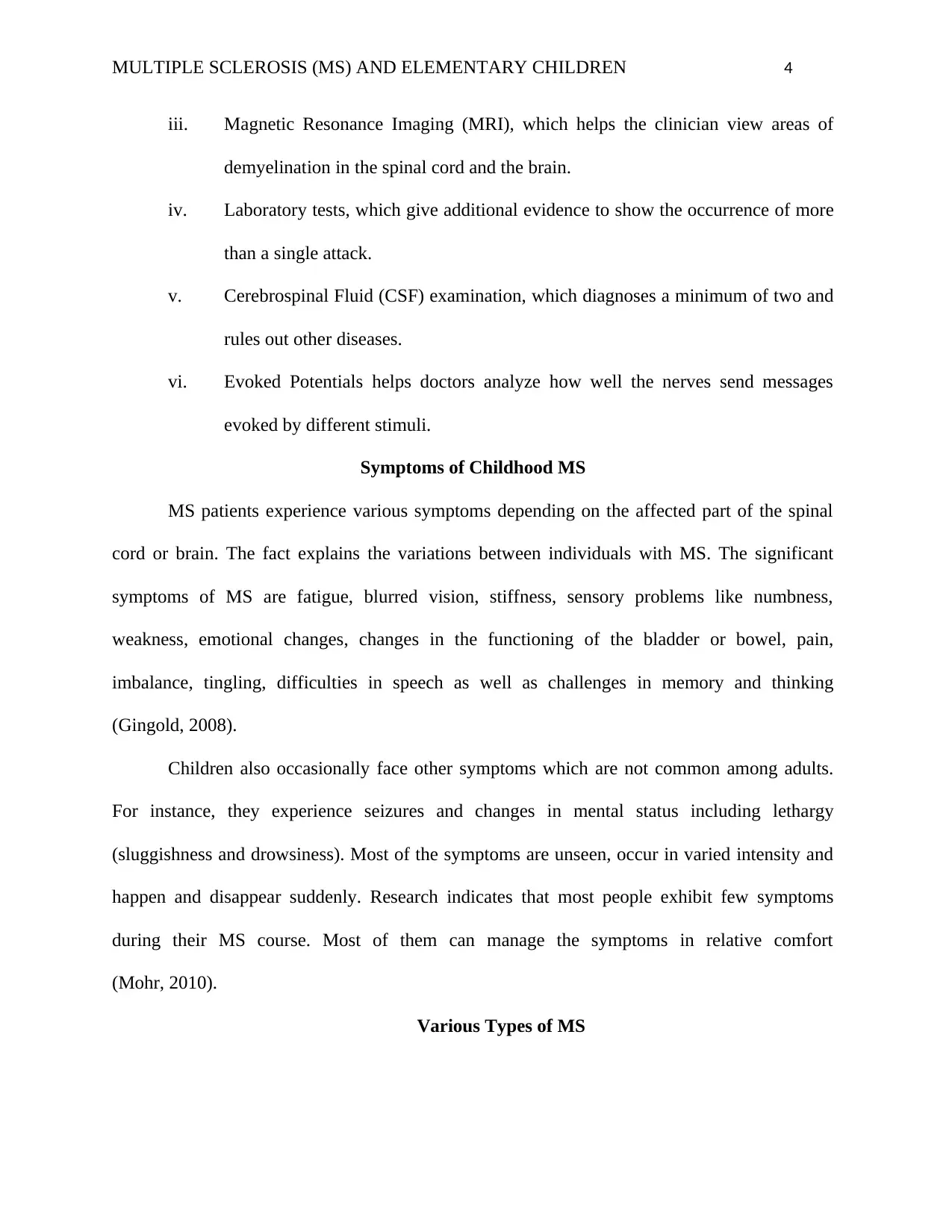
MULTIPLE SCLEROSIS (MS) AND ELEMENTARY CHILDREN 4
iii. Magnetic Resonance Imaging (MRI), which helps the clinician view areas of
demyelination in the spinal cord and the brain.
iv. Laboratory tests, which give additional evidence to show the occurrence of more
than a single attack.
v. Cerebrospinal Fluid (CSF) examination, which diagnoses a minimum of two and
rules out other diseases.
vi. Evoked Potentials helps doctors analyze how well the nerves send messages
evoked by different stimuli.
Symptoms of Childhood MS
MS patients experience various symptoms depending on the affected part of the spinal
cord or brain. The fact explains the variations between individuals with MS. The significant
symptoms of MS are fatigue, blurred vision, stiffness, sensory problems like numbness,
weakness, emotional changes, changes in the functioning of the bladder or bowel, pain,
imbalance, tingling, difficulties in speech as well as challenges in memory and thinking
(Gingold, 2008).
Children also occasionally face other symptoms which are not common among adults.
For instance, they experience seizures and changes in mental status including lethargy
(sluggishness and drowsiness). Most of the symptoms are unseen, occur in varied intensity and
happen and disappear suddenly. Research indicates that most people exhibit few symptoms
during their MS course. Most of them can manage the symptoms in relative comfort
(Mohr, 2010).
Various Types of MS
iii. Magnetic Resonance Imaging (MRI), which helps the clinician view areas of
demyelination in the spinal cord and the brain.
iv. Laboratory tests, which give additional evidence to show the occurrence of more
than a single attack.
v. Cerebrospinal Fluid (CSF) examination, which diagnoses a minimum of two and
rules out other diseases.
vi. Evoked Potentials helps doctors analyze how well the nerves send messages
evoked by different stimuli.
Symptoms of Childhood MS
MS patients experience various symptoms depending on the affected part of the spinal
cord or brain. The fact explains the variations between individuals with MS. The significant
symptoms of MS are fatigue, blurred vision, stiffness, sensory problems like numbness,
weakness, emotional changes, changes in the functioning of the bladder or bowel, pain,
imbalance, tingling, difficulties in speech as well as challenges in memory and thinking
(Gingold, 2008).
Children also occasionally face other symptoms which are not common among adults.
For instance, they experience seizures and changes in mental status including lethargy
(sluggishness and drowsiness). Most of the symptoms are unseen, occur in varied intensity and
happen and disappear suddenly. Research indicates that most people exhibit few symptoms
during their MS course. Most of them can manage the symptoms in relative comfort
(Mohr, 2010).
Various Types of MS
Secure Best Marks with AI Grader
Need help grading? Try our AI Grader for instant feedback on your assignments.
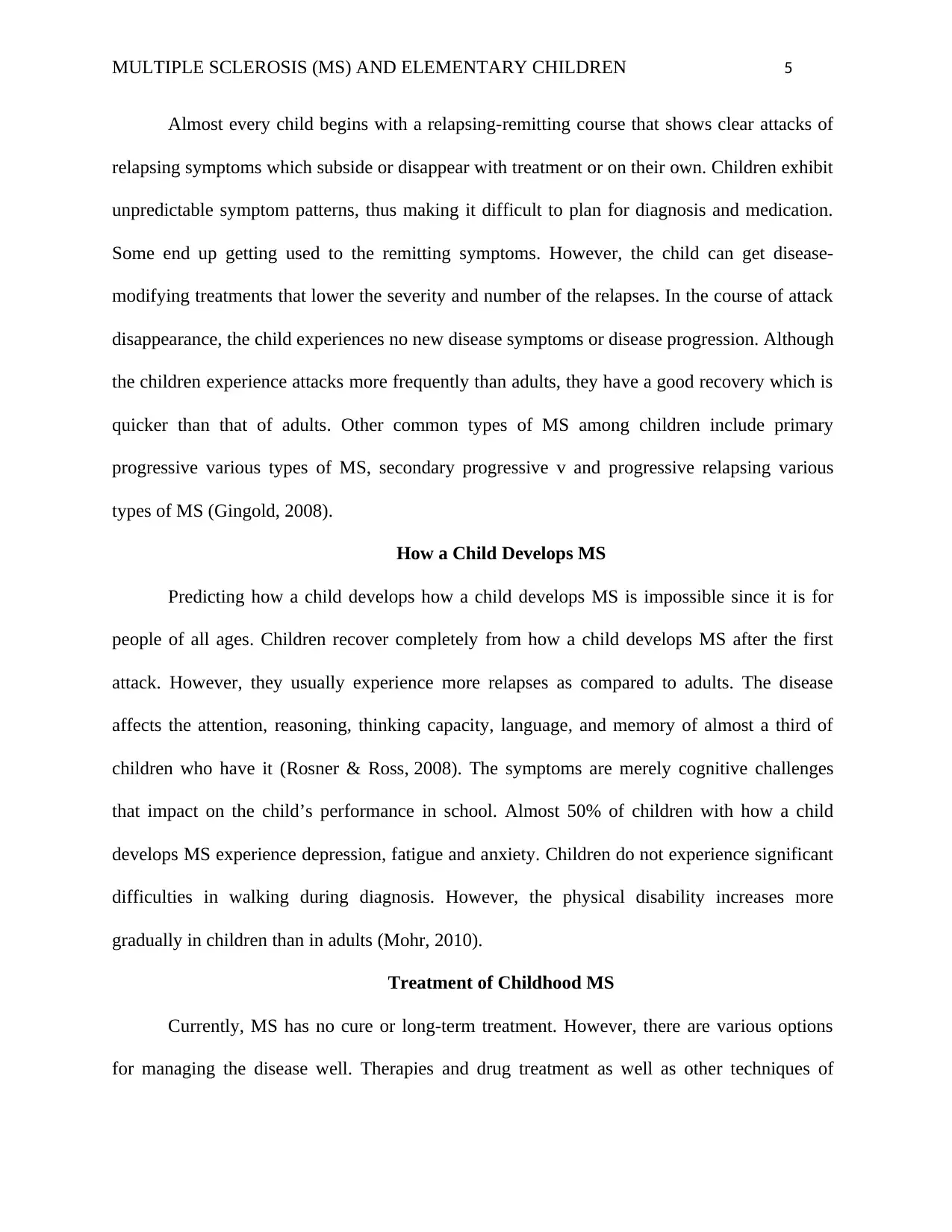
MULTIPLE SCLEROSIS (MS) AND ELEMENTARY CHILDREN 5
Almost every child begins with a relapsing-remitting course that shows clear attacks of
relapsing symptoms which subside or disappear with treatment or on their own. Children exhibit
unpredictable symptom patterns, thus making it difficult to plan for diagnosis and medication.
Some end up getting used to the remitting symptoms. However, the child can get disease-
modifying treatments that lower the severity and number of the relapses. In the course of attack
disappearance, the child experiences no new disease symptoms or disease progression. Although
the children experience attacks more frequently than adults, they have a good recovery which is
quicker than that of adults. Other common types of MS among children include primary
progressive various types of MS, secondary progressive v and progressive relapsing various
types of MS (Gingold, 2008).
How a Child Develops MS
Predicting how a child develops how a child develops MS is impossible since it is for
people of all ages. Children recover completely from how a child develops MS after the first
attack. However, they usually experience more relapses as compared to adults. The disease
affects the attention, reasoning, thinking capacity, language, and memory of almost a third of
children who have it (Rosner & Ross, 2008). The symptoms are merely cognitive challenges
that impact on the child’s performance in school. Almost 50% of children with how a child
develops MS experience depression, fatigue and anxiety. Children do not experience significant
difficulties in walking during diagnosis. However, the physical disability increases more
gradually in children than in adults (Mohr, 2010).
Treatment of Childhood MS
Currently, MS has no cure or long-term treatment. However, there are various options
for managing the disease well. Therapies and drug treatment as well as other techniques of
Almost every child begins with a relapsing-remitting course that shows clear attacks of
relapsing symptoms which subside or disappear with treatment or on their own. Children exhibit
unpredictable symptom patterns, thus making it difficult to plan for diagnosis and medication.
Some end up getting used to the remitting symptoms. However, the child can get disease-
modifying treatments that lower the severity and number of the relapses. In the course of attack
disappearance, the child experiences no new disease symptoms or disease progression. Although
the children experience attacks more frequently than adults, they have a good recovery which is
quicker than that of adults. Other common types of MS among children include primary
progressive various types of MS, secondary progressive v and progressive relapsing various
types of MS (Gingold, 2008).
How a Child Develops MS
Predicting how a child develops how a child develops MS is impossible since it is for
people of all ages. Children recover completely from how a child develops MS after the first
attack. However, they usually experience more relapses as compared to adults. The disease
affects the attention, reasoning, thinking capacity, language, and memory of almost a third of
children who have it (Rosner & Ross, 2008). The symptoms are merely cognitive challenges
that impact on the child’s performance in school. Almost 50% of children with how a child
develops MS experience depression, fatigue and anxiety. Children do not experience significant
difficulties in walking during diagnosis. However, the physical disability increases more
gradually in children than in adults (Mohr, 2010).
Treatment of Childhood MS
Currently, MS has no cure or long-term treatment. However, there are various options
for managing the disease well. Therapies and drug treatment as well as other techniques of
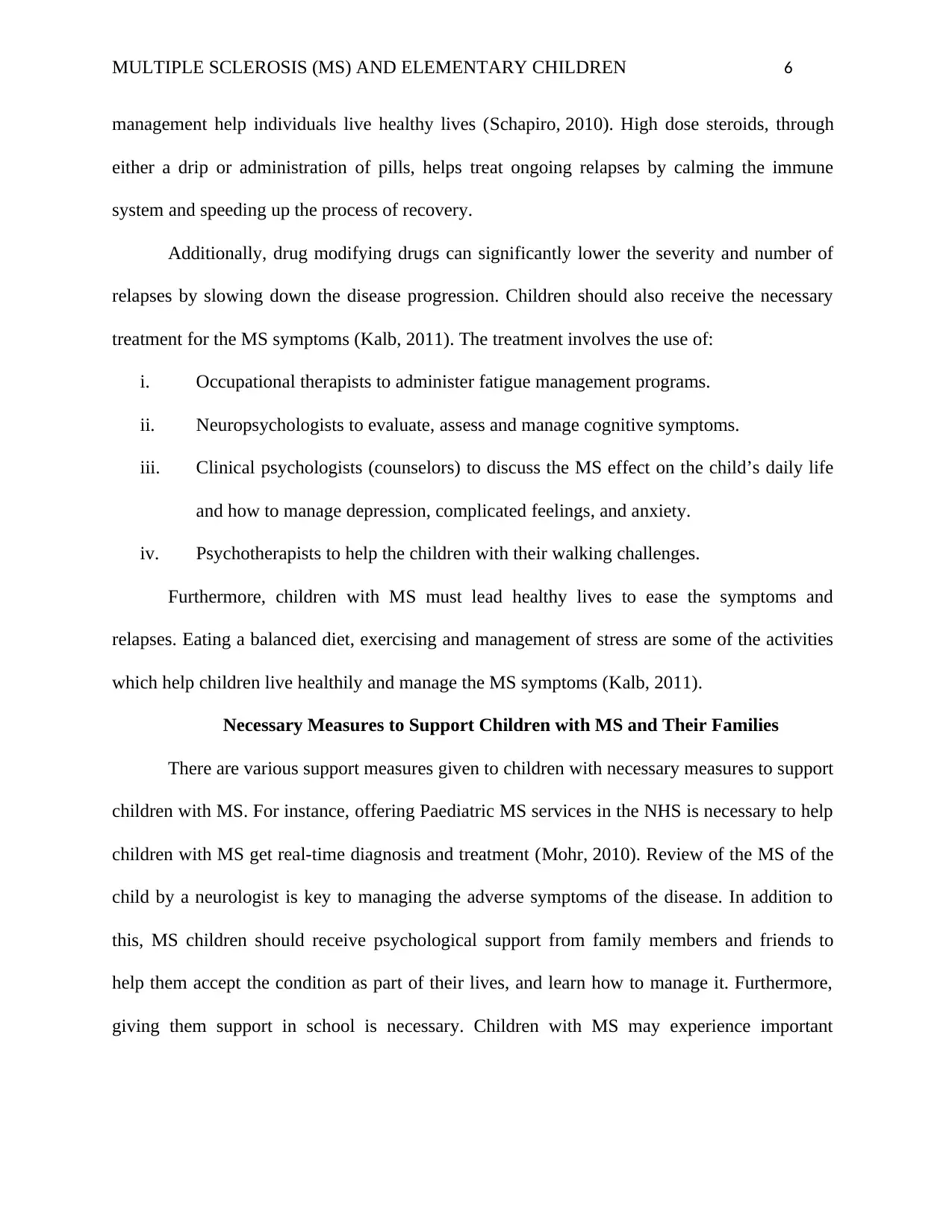
MULTIPLE SCLEROSIS (MS) AND ELEMENTARY CHILDREN 6
management help individuals live healthy lives (Schapiro, 2010). High dose steroids, through
either a drip or administration of pills, helps treat ongoing relapses by calming the immune
system and speeding up the process of recovery.
Additionally, drug modifying drugs can significantly lower the severity and number of
relapses by slowing down the disease progression. Children should also receive the necessary
treatment for the MS symptoms (Kalb, 2011). The treatment involves the use of:
i. Occupational therapists to administer fatigue management programs.
ii. Neuropsychologists to evaluate, assess and manage cognitive symptoms.
iii. Clinical psychologists (counselors) to discuss the MS effect on the child’s daily life
and how to manage depression, complicated feelings, and anxiety.
iv. Psychotherapists to help the children with their walking challenges.
Furthermore, children with MS must lead healthy lives to ease the symptoms and
relapses. Eating a balanced diet, exercising and management of stress are some of the activities
which help children live healthily and manage the MS symptoms (Kalb, 2011).
Necessary Measures to Support Children with MS and Their Families
There are various support measures given to children with necessary measures to support
children with MS. For instance, offering Paediatric MS services in the NHS is necessary to help
children with MS get real-time diagnosis and treatment (Mohr, 2010). Review of the MS of the
child by a neurologist is key to managing the adverse symptoms of the disease. In addition to
this, MS children should receive psychological support from family members and friends to
help them accept the condition as part of their lives, and learn how to manage it. Furthermore,
giving them support in school is necessary. Children with MS may experience important
management help individuals live healthy lives (Schapiro, 2010). High dose steroids, through
either a drip or administration of pills, helps treat ongoing relapses by calming the immune
system and speeding up the process of recovery.
Additionally, drug modifying drugs can significantly lower the severity and number of
relapses by slowing down the disease progression. Children should also receive the necessary
treatment for the MS symptoms (Kalb, 2011). The treatment involves the use of:
i. Occupational therapists to administer fatigue management programs.
ii. Neuropsychologists to evaluate, assess and manage cognitive symptoms.
iii. Clinical psychologists (counselors) to discuss the MS effect on the child’s daily life
and how to manage depression, complicated feelings, and anxiety.
iv. Psychotherapists to help the children with their walking challenges.
Furthermore, children with MS must lead healthy lives to ease the symptoms and
relapses. Eating a balanced diet, exercising and management of stress are some of the activities
which help children live healthily and manage the MS symptoms (Kalb, 2011).
Necessary Measures to Support Children with MS and Their Families
There are various support measures given to children with necessary measures to support
children with MS. For instance, offering Paediatric MS services in the NHS is necessary to help
children with MS get real-time diagnosis and treatment (Mohr, 2010). Review of the MS of the
child by a neurologist is key to managing the adverse symptoms of the disease. In addition to
this, MS children should receive psychological support from family members and friends to
help them accept the condition as part of their lives, and learn how to manage it. Furthermore,
giving them support in school is necessary. Children with MS may experience important
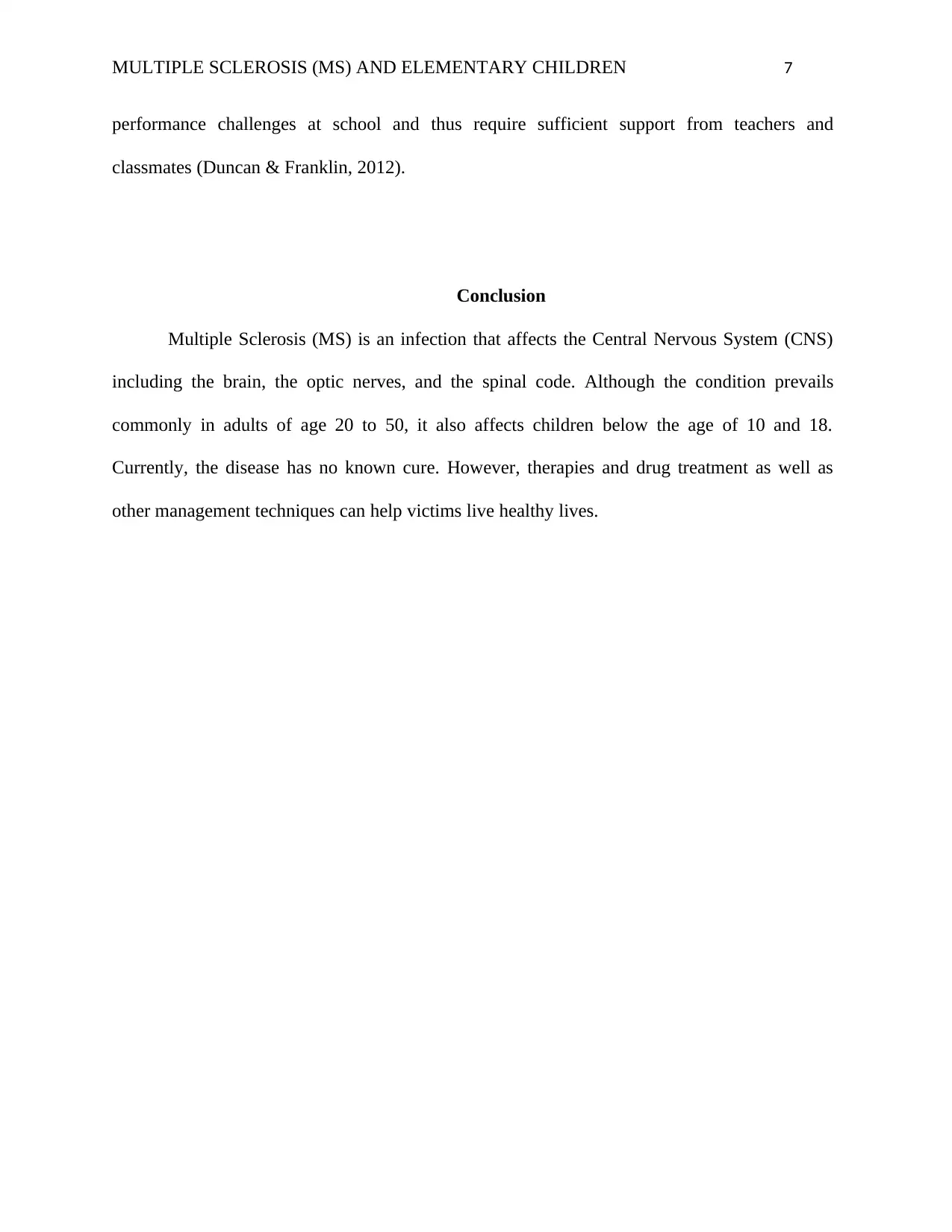
MULTIPLE SCLEROSIS (MS) AND ELEMENTARY CHILDREN 7
performance challenges at school and thus require sufficient support from teachers and
classmates (Duncan & Franklin, 2012).
Conclusion
Multiple Sclerosis (MS) is an infection that affects the Central Nervous System (CNS)
including the brain, the optic nerves, and the spinal code. Although the condition prevails
commonly in adults of age 20 to 50, it also affects children below the age of 10 and 18.
Currently, the disease has no known cure. However, therapies and drug treatment as well as
other management techniques can help victims live healthy lives.
performance challenges at school and thus require sufficient support from teachers and
classmates (Duncan & Franklin, 2012).
Conclusion
Multiple Sclerosis (MS) is an infection that affects the Central Nervous System (CNS)
including the brain, the optic nerves, and the spinal code. Although the condition prevails
commonly in adults of age 20 to 50, it also affects children below the age of 10 and 18.
Currently, the disease has no known cure. However, therapies and drug treatment as well as
other management techniques can help victims live healthy lives.
Paraphrase This Document
Need a fresh take? Get an instant paraphrase of this document with our AI Paraphraser
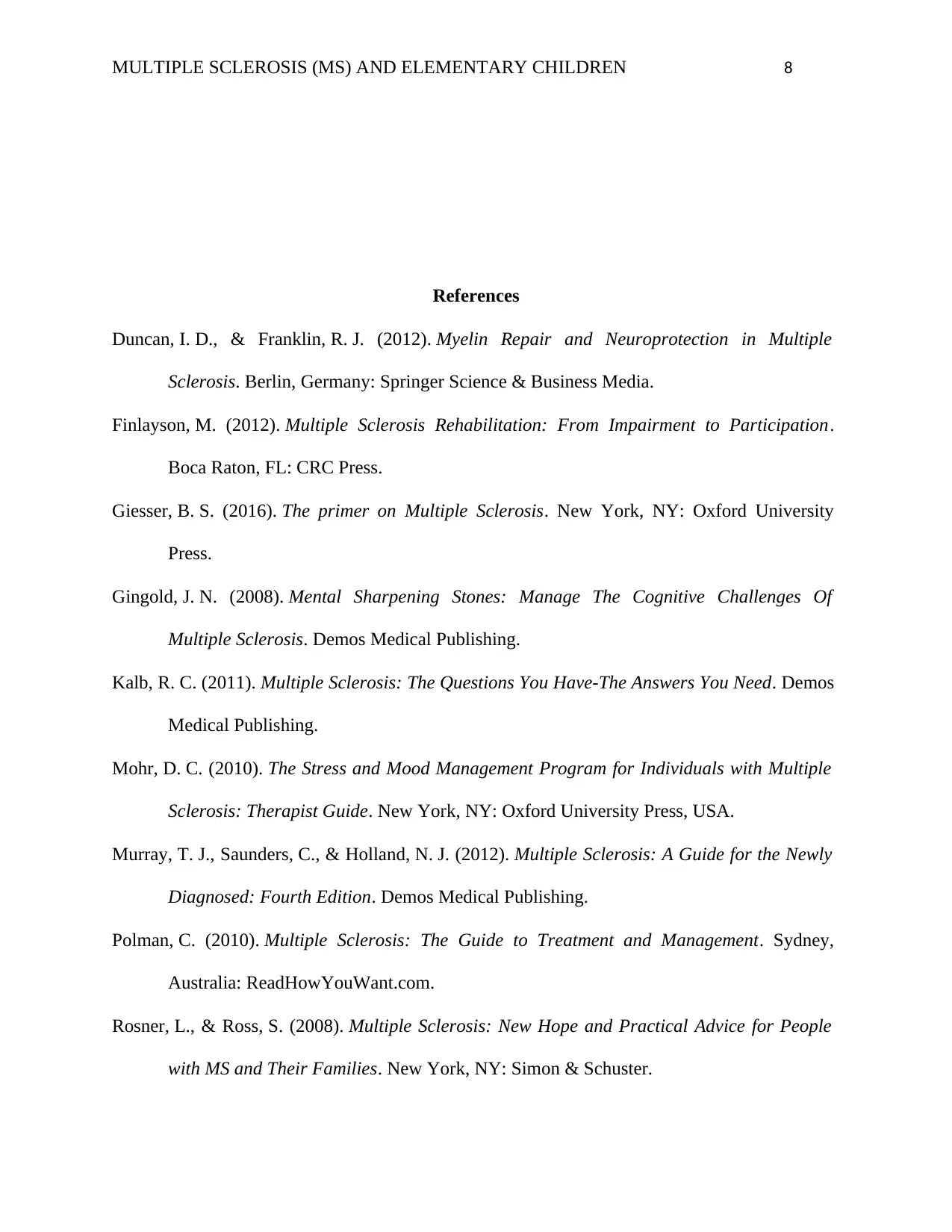
MULTIPLE SCLEROSIS (MS) AND ELEMENTARY CHILDREN 8
References
Duncan, I. D., & Franklin, R. J. (2012). Myelin Repair and Neuroprotection in Multiple
Sclerosis. Berlin, Germany: Springer Science & Business Media.
Finlayson, M. (2012). Multiple Sclerosis Rehabilitation: From Impairment to Participation.
Boca Raton, FL: CRC Press.
Giesser, B. S. (2016). The primer on Multiple Sclerosis. New York, NY: Oxford University
Press.
Gingold, J. N. (2008). Mental Sharpening Stones: Manage The Cognitive Challenges Of
Multiple Sclerosis. Demos Medical Publishing.
Kalb, R. C. (2011). Multiple Sclerosis: The Questions You Have-The Answers You Need. Demos
Medical Publishing.
Mohr, D. C. (2010). The Stress and Mood Management Program for Individuals with Multiple
Sclerosis: Therapist Guide. New York, NY: Oxford University Press, USA.
Murray, T. J., Saunders, C., & Holland, N. J. (2012). Multiple Sclerosis: A Guide for the Newly
Diagnosed: Fourth Edition. Demos Medical Publishing.
Polman, C. (2010). Multiple Sclerosis: The Guide to Treatment and Management. Sydney,
Australia: ReadHowYouWant.com.
Rosner, L., & Ross, S. (2008). Multiple Sclerosis: New Hope and Practical Advice for People
with MS and Their Families. New York, NY: Simon & Schuster.
References
Duncan, I. D., & Franklin, R. J. (2012). Myelin Repair and Neuroprotection in Multiple
Sclerosis. Berlin, Germany: Springer Science & Business Media.
Finlayson, M. (2012). Multiple Sclerosis Rehabilitation: From Impairment to Participation.
Boca Raton, FL: CRC Press.
Giesser, B. S. (2016). The primer on Multiple Sclerosis. New York, NY: Oxford University
Press.
Gingold, J. N. (2008). Mental Sharpening Stones: Manage The Cognitive Challenges Of
Multiple Sclerosis. Demos Medical Publishing.
Kalb, R. C. (2011). Multiple Sclerosis: The Questions You Have-The Answers You Need. Demos
Medical Publishing.
Mohr, D. C. (2010). The Stress and Mood Management Program for Individuals with Multiple
Sclerosis: Therapist Guide. New York, NY: Oxford University Press, USA.
Murray, T. J., Saunders, C., & Holland, N. J. (2012). Multiple Sclerosis: A Guide for the Newly
Diagnosed: Fourth Edition. Demos Medical Publishing.
Polman, C. (2010). Multiple Sclerosis: The Guide to Treatment and Management. Sydney,
Australia: ReadHowYouWant.com.
Rosner, L., & Ross, S. (2008). Multiple Sclerosis: New Hope and Practical Advice for People
with MS and Their Families. New York, NY: Simon & Schuster.

MULTIPLE SCLEROSIS (MS) AND ELEMENTARY CHILDREN 9
Schapiro, R. T. (2010). Managing the Symptoms of Multiple Sclerosis: Fifth Edition. Sydney,
Australia: ReadHowYouWant.com.
Schapiro, R. T. (2010). Managing the Symptoms of Multiple Sclerosis: Fifth Edition. Sydney,
Australia: ReadHowYouWant.com.
1 out of 9
Related Documents
Your All-in-One AI-Powered Toolkit for Academic Success.
+13062052269
info@desklib.com
Available 24*7 on WhatsApp / Email
![[object Object]](/_next/static/media/star-bottom.7253800d.svg)
Unlock your academic potential
© 2024 | Zucol Services PVT LTD | All rights reserved.





